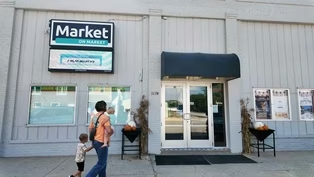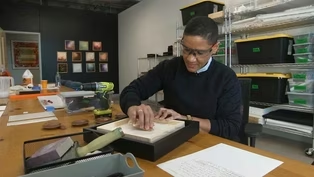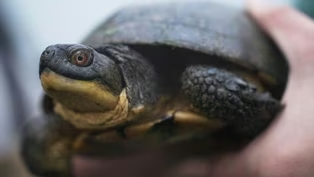
March 1857 Spirit Lake Massacre Explained by Historian Kevin Mason
Clip: Season 3 Episode 302 | 5m 23sVideo has Closed Captions
Historian Kevin Mason recounts the events of March 1857, known as the Spirit Lake Massacre.
Historian Kevin Mason recounts the events of March 1857, known as the Spirit Lake Massacre. Through Mason’s storytelling, we gain insight into the complex circumstances, fears, and human experiences that shaped this tragic chapter in Iowa’s history.
Problems playing video? | Closed Captioning Feedback
Problems playing video? | Closed Captioning Feedback
Iowa Life is a local public television program presented by Iowa PBS

March 1857 Spirit Lake Massacre Explained by Historian Kevin Mason
Clip: Season 3 Episode 302 | 5m 23sVideo has Closed Captions
Historian Kevin Mason recounts the events of March 1857, known as the Spirit Lake Massacre. Through Mason’s storytelling, we gain insight into the complex circumstances, fears, and human experiences that shaped this tragic chapter in Iowa’s history.
Problems playing video? | Closed Captioning Feedback
How to Watch Iowa Life
Iowa Life is available to stream on pbs.org and the free PBS App, available on iPhone, Apple TV, Android TV, Android smartphones, Amazon Fire TV, Amazon Fire Tablet, Roku, Samsung Smart TV, and Vizio.
Providing Support for PBS.org
Learn Moreabout PBS online sponsorship[Nebbe] History often leaves us with more questions than answers, especially when we look closely at difficult chapters from our past.
On the shore of West Okoboji Lake, at the Abbie Gardner Sharp Cabin, students uncover traces of daily life while also confronting a much deeper story.
In March of 1857, this place became the center of what is known as the Spirit Lake Massacre, a tragic moment in Iowa's history.
[Kevin Mason] It's not a simple story.
This is the story of American settlement in a way that I think is important for us to remember and try to understand better.
[Nebbe] The Spirit Lake Massacre was more than a single violent event.
It was part of the sweeping transformation of the American frontier.
Inkpaduta was the leader of the Wahpekute Dakota, a group whose life centered on summering at Spirit Lake and wintering near the confluence of the Little Sioux and Missouri rivers.
[Mason] And as Inkpaduta grows up, he sees this incredible change come to the lands the Dakota have been living in for hundreds, if not thousands of years.
We're talking about complete conversion of prairies.
Iowa's going to lose 99% of its prairie lands.
We're going to lose almost all of our wetlands.
[Nebbe] This loss will forever change the Dakota way of life.
[Mason] So, the most simple way to think about kind of the timeline of events with Spirit Lake in 1857 is Inkpaduta is going to bring his tiyospaye, or band, down to Smithland, which is in modern day Woodbury County.
Over the summer of 1856, we're going to see new groups of people move into Smithland, and they are going to be trying to scratch out a life for themselves that's going to come into competition for land and natural resources with the Dakota.
And the Dakota had been coming to Smithland as far as the Western record goes back.
There's a farmer there named Curtis Lamb who, once he makes his claim, the Dakota come and stay on his land.
[Nebbe] A series of misfortunes set the stage for what was to come.
In the summer of 1856, Curtis Lamb sold his land and moved to Sioux City.
The farmer who bought it was not hospitable to the Dakota.
That fall, a prairie fire burned through hay fields needed to feed the settlers livestock.
And then came the winter of 1856-1857, the harshest in Iowa's history, bringing months of cold, snow and hardship.
[Mason] The settlers of Smithland are really struggling.
They're already desperate before the Dakota even arrive.
They form a militia and they confront the Dakota.
They tell them, we're going to disarm you and you're going to leave.
The Dakota are going to flee up the Little Sioux River heading towards Spirit Lake.
It's a place Inkpaduta had often been during the summer.
When he had last been through the Great Lakes, there was no settlers there.
As they head up the Little Sioux River, things go from bad to worse.
One of Inkpaduta's grandchildren starves to death.
They break into some cabins.
They have some conflicts with some different settlers as they're moving up the river.
[Nebbe] When Inkpaduta and his band reached Spirit Lake, they encountered the settlement where several families had built cabins.
Abbie Gardner Sharp's memoir describes how the Dakota attacked the settlement.
[Mason] She talks about her mother, feeds the Dakota in the morning, they come back in the afternoon.
Then her dad turns around and Inkpaduta allegedly shoots Rowland Gardner in the back.
We do know that Abbie is taken captive, that Dakota kill the rest of her family in front of her, including her parents, her infant brother, and then they move through the lakes all the way up to Jackson, Minnesota, actively trying to destroy the settlement there.
Over 36 people are going to lose their lives as this happens.
Four women are going to be taken captive, two of which later also die as the Dakota flee west.
Sometimes I think about it as like the last gasp of the frontier in that Inkpaduta is going to strike back against this settlement, of course, but in a way that's going to force him to flee west and stay west for the rest of his life.
And we get into this really difficult historical reckoning where we have Abbie's story, we have the Dakota stories.
And I always am trying to challenge people to think about, like, well, what would you do to preserve your home, your way of life, and then what would it take before we start to see this violence?
And I think, like, if we continue to avoid the difficult things in our past and we try to gloss over them and not look hard at complex things, then we lose a part of who we are, and we certainly lose the potential of who we can become by confronting those things.
♪♪
Gowrie’s Market on Market: Community Support Keeps Grocery Store Alive in Rural Iowa
Video has Closed Captions
Clip: S3 Ep302 | 6m 41s | In Gowrie, a town of 900, the local grocery thrives due to creative thinking and community support. (6m 41s)
How Artist Jill Wells Uses Braille to Make Art Accessible for Everyone
Video has Closed Captions
Clip: S3 Ep302 | 6m 3s | For Des Moines-based artist Jill Wells, her artwork is purposely tactile for accessibility. (6m 3s)
Iowa Lakeside Laboratories History and Modern Day Research on Blanding Turtles In Okoboji
Video has Closed Captions
Clip: S3 Ep302 | 6m 43s | Iowa Lakeside Laboratories was founded for the purpose of studying nature in nature. (6m 43s)
Providing Support for PBS.org
Learn Moreabout PBS online sponsorshipSupport for PBS provided by:
Iowa Life is a local public television program presented by Iowa PBS
















